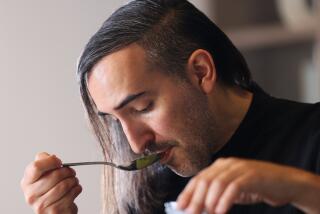Dining on foodie books from Colman Andrews, Luke Barr, Allen Salkin
It’s hard to believe that only 50 years have passed since Julia Child set foot on the new continent of American Foodlandia. And yet in that short period, it seems we’ve already seen the full cycle of colonial development: discovery, exploration, exploitation.
Three books on recent food history offer glimpses of each stage. Luke Barr’s “Provence, 1970” describes the beginning; Colman Andrews’ “My Usual Table” hits the middle period; and Allen Salkin’s “From Scratch,” a pulp history of the Food Network, covers the descent into decadence.
By far the best of these is Andrews’ “My Usual Table.” One of the seminal characters in modern American food writing, he fits in neatly between the casts of “Provence” and TVFN. One of the crew of restaurant critics at New West magazine who helped launch California cuisine in the 1970s, he was also the founding editor at Saveur magazine and has served various stints at other publications, including the Los Angeles Times in the 1980s and early 1990s.
Andrews’ memoir is a throwback to the early days of our food fascination when a handful of passionate geeks set out to explore this wide new world. A child of Hollywood raised at Chasen’s and Trader Vic’s, he seems to have eaten everywhere, always searching for that flash of happiness that comes from finding a great meal or even just a great place.
It is his happy talent for being able to appreciate both of those that makes “My Usual Table” such a pleasure to read. Certainly, there was memorable food — he was there when Wolfgang Puck first started cooking at Ma Maison; he seems to have eaten at every three-star restaurant in Europe; and he was one of the first to write about modernist wunderkind Ferran Adria.
But there’s more to life — and to restaurants — than foie gras, great vintages and gold fixtures. And Andrews gets that exactly right, giving full respect to great places where the food may have been merely good but where he was, for a time, happy.
The book also touches on what that single-minded pursuit cost him in dollars and cents (he seems to have been perennially broke) and personally (he is a man of many wives and even more relationships … and, yes, in case you were wondering, he does tell his side of the story of his affair with Ruth Reichl).
He devotes a full chapter to the West Hollywood dive called Ports, where the eccentric owners threw together a menu that combined everything from Moroccan eggplant salad to chicken livers in Marsala sauce yet which also offered a rotating cast of great characters, including jazz musicians, artists and actors. So who’s going to quibble about a lack of focus in the menu?
It’s this ability to appreciate food in a larger context that makes Andrews’ book so appealing — and such a welcome antidote to so much of the food discussion today, which seems to oscillate between show business puffery and hyper-critical instant analysis.
In “Provence, 1970,” Barr takes us back to the early days of modern American food appreciation, reconstructing what he posits to be a pivotal moment when Julia Child, James Beard, Richard Olney and Barr’s great-aunt M.F.K. Fisher spent Christmas together in France. The book is based on Fisher’s papers from the period.
He argues that it was during this holiday — less than a decade after the “big bang” publication of Child’s “Mastering the Art of French Cooking” — that Child, Beard and Fisher began to reassess their devotion to France as the fount of all good food. Maybe there was more to this old-time American cooking after all?
Although the book offers a fascinating glimpse of that very different time, Barr never really pursues his theory to its conclusion. And even with that much culinary firepower gathered under one roof, including the notoriously bitchy Beard and Olney as well as Child’s difficult co-writer Simone Beck, the fireworks seem to be hinted at rather than observed.
Of course, if it’s catty tell-alls you want, you can turn to “From Scratch,” in which Salkin brings a pop journalist’s eye to the development of the network that would provide the ultimate exploitation of food and cooking.
“From Scratch” is packed with incident, which is not to be confused with insight. If you want to know how Food Network founder Reese Schonfeld built the channel with the broadcasting equivalent of bubble gum and duct tape, that’s here. As is how he lost the network after it became a cultural phenomenon.
There’s plenty of good gossip to be had — the rise and fall of Emeril Lagasse is practically Shakespearean. And I loved how, reportedly, one TVFN president declared after negotiating with Martha Stewart: “The only thing I want in this agreement is I don’t ever want to have to see that woman again for the life of the contract.”
Salkin seems to have interviewed almost everyone connected with the channel, and he’s good on the behind-the-scenes business machinations. But there are occasional missteps in his food specifics and, frankly, being locked in a book with the juiced-up egos of such titans as Guy Fieri, Robert Irvine and Paula Deen is more than a little dispiriting. You may want to shower after. Or just cook a good meal.
My Usual Table: A Life in Restaurants
Colman Andrews
Ecco: 322 pp, $25.99
Provence, 1970: M.F.K. Fisher, Julia Child, James Beard, and the Reinvention of American Taste
Luke Barr
Clarkson Potter: 320 pp, $26
From Scratch: Inside the Food Network
Allen Salkin
Putnam: 434 pp, $27.95
More to Read
Sign up for our Book Club newsletter
Get the latest news, events and more from the Los Angeles Times Book Club, and help us get L.A. reading and talking.
You may occasionally receive promotional content from the Los Angeles Times.








